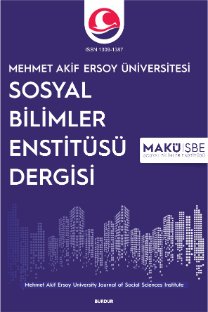ÜSTÜN EVRENSEL DEĞER KAVRAMININ UYGULANABİLİRLİĞİNE YÖNELİK ÇABALAR
Dünya Kültürel ve Doğal Mirasının Korunmasına Dair Sözleşme ile ortaya çıkan üstün evrensel değer kavramı, UNESCO Dünya Miras Listesi’ne aday olan miraslara ilişkin en önemli ön koşullardan birisidir. Fakat bu ön koşulun pratikte ne şekilde uygulanacağının kararlaştırılmasına yönelik çabalar, ancak uzun yıllar boyunca süren tartışmalar sonrasında bir sonuca ulaştırılabilmiştir. Üstün evrensel değer kavramının tanımı, 2005 yılına kadar süren tartışmalar sonucunda yapılmıştır. Ancak teoride ortaya konulmuş olsa da Listeye yönelik uygulanmasında bir geçiş dönemi yaşanmış ve 2009 yılı, kavramın pratikte nasıl ele alınması gerektiğine dair bir kırılma noktası olmuştur.
Anahtar Kelimeler:
Üstün Evrensel Değer, Sanat Tarihi, Mimarî Koruma ve Restorasyon Araştırmaları, UNESCO Dünya Miras Listesi’ne Yönelik Adaylık Süreci, UNESCO Dünya Miras Alanı, Üstün Evrensel Değer.
EFFORTS ON THE APPLICABILITY OF THE CONCEPT OF OUTSTANDING UNIVERSAL VALUE
The concept of outstanding universal value, which emerged with the Convention Concerning the Protection of the World Cultural and Natural Heritage, is one of the most important prerequisites for the heritages that are candidates for the UNESCO World Heritage List. However, efforts to decide how this prerequisite should be applied in practice could only come to a conclusion after many years of discussions. The definition of the concept of outstanding universal value was made as a result of the discussions that lasted until 2005. However, although it was put forward in theory, there was a transition period in its implementation within the scope of the listing process and 2009 became a breaking point in how the concept should be handled in practice.
Keywords:
History of Art, Architectural Conservation and Restoration Research, Nomination Process for the UNESCO World Heritage List, UNESCO World Heritage Site, Outstanding Universal Value.,
___
- Cleere, H. (1996). The Concept of 'Outstanding Universal Value' in the World Heritage Convention. Conservation and Management of Archaeological Sites, 1, 227-233.
- Francioni, F. (2002). The International Framework of Legal Instruments. UNESCO Workshop Abstracts: The Legal Tools for World Heritage Conservation—Sienna November 11–12 (yayınlanmamış). Paris: UNESCO, s. 1–4.
- International Council on Monuments and Sites (2004). The World Heritage List: Filling the Gaps - an Action Plan for the Future (An Analysis by ICOMOS). Paris: International Council on Monuments and Sites.
- Labadi, S. (2013). UNESCO, Cultural Heritage, and Outstanding Universal Value. Plymouth: AltaMira Press.
- Merryman, J. H. (1986). Two Ways of Thinking About Cultural Property. The American Journal of International Law, 80(4), 831-853.
- Nian, S., Zhang, H., Mao, L., Zhao, W., Zhang, H., Lu, Y., Zhang, Y. ve Xu, Y. (2019). How Outstanding Universal Value, Service Quality and Place Attachment Influences Tourist Intention Towards World Heritage Conservation: A Case Study of Mount Sanqingshan National Park, China. Sustainability, 11(12): 3321 sayılı makale.”
- Pendlebury, J., Short, M. ve While, A. (2009). Urban World Heritage Sites and the Problem of Authenticity. Cities, 26(6), 349–358.
- Pereira Roders, A. ve van Oers, R. (2010). Outstanding universal value, world heritage cities and sustainability: mapping assessment processes. D. Offenhäußer, W. C. Zimmerli ve M. T. Albert (Ed.) içinde. World Heritage and Cultural Diversity (ss. 225-236). Cottbus: German Commission for UNESCO, DRUCKZONE GmbH & Co. KG.
- Reid, D. M. (1992). Cultural Imperialism and Nationalism: The Struggle to Define and Control the Heritage of Arab Art in Egypt. International Journal of Middle East Studies, 24(1), 57-76.
- UNESCO World Heritage Centre (1977). Operational Guidelines for the Implementation of the World Heritage Convention. Paris: UNESCO World Heritage Centre.
- UNESCO World Heritage Centre (1980). Report of the Rapporteur on the Fourth Session of the World Heritage Committee. Paris: UNESCO World Heritage Centre.
- UNESCO World Heritage Centre (1998). Report of the World Heritage Global Strategy Natural and Cultural Heritage Expert Meeting, 25 to 29 March 1998, Theatre Institute, Amsterdam, The Netherlands. World Heritage Committee Twenty-second session, Information Document (WHC-98/CONF.203/INF.7). Paris: UNESCO World Heritage Centre.
- UNESCO World Heritage Centre (2004). Decisions Adopted at the 28th Session of the World Heritage Committee (Suzhou, 2004). Paris: UNESCO World Heritage Centre.
- UNESCO World Heritage Centre (2005a). Operational Guidelines for the Implementation of the World Heritage Convention. Paris: UNESCO World Heritage Centre.
- UNESCO World Heritage Centre (2005b). Decisions of the 29th Session of the World Heritage Committee (Durban, 2005). Paris: UNESCO World Heritage Centre.
- UNESCO World Heritage Centre (2006). Decisions Adopted at the 30th Session of the World Heritage Committee (Vilnıus, 2006). Paris: UNESCO World Heritage Centre.
- UNESCO World Heritage Centre (2007). Decisions Adopted at the 31st Session of the World Heritage Committee (Christchurch, 2007). Paris: UNESCO World Heritage Centre.
- UNESCO World Heritage Centre (2008). Decisions Adopted at the 32nd Session of the World Heritage Committee (Quebec City, 2008). Paris: UNESCO World Heritage Centre.
- UNESCO World Heritage Centre, (2019). Operational Guidelines for the Implementation of the World Heritage Convention. Paris: UNESCO World Heritage Centre.
- UNESCO World Heritage Centre (2022). UNESCO World Heritage Convention. http://whc.unesco.org.
- Ürün, Ş. (2016). Dünya Kültürel ve Doğal Mirasın Korunmasına Dair Sözleşme: Doğal Miras Alanları Başvuru, Adaylık ve Değerlendirme Süreçleri. Ankara: UNESCO Türkiye Millî Komisyonu.
- Yayın Aralığı: Yılda 2 Sayı
- Başlangıç: 2009
- Yayıncı: Burdur Mehmet Akif Ersoy Üniversitesi Sosyal Bilimler Enstitüsü
Sayıdaki Diğer Makaleler
TEDARİKÇİ SEÇİMİ PROBLEMİNİN AHP TEMELLİ MAIRCA YÖNTEMİ İLE ÇÖZÜMÜ
BAHTİYAR VAHABZADE: GEÇİP GİDEN ZAMANA NOTLAR
DENİM KUMAŞIN SANAT MALZEMESİ OLARAK KULLANIMINA YÖNELİK DENEYSEL YAKLAŞIMLAR
ANTİK ÇAĞIN TEHLİKELİ YÖNETİMİNDEN GÜNÜMÜZÜN VAZGEÇİLMEZ REJİMİNE: DEMOKRASİ
Abdulvahap AKINCI, Emrullah Mert KOYUNCU
MODERN TERÖR ÖRGÜTLERİNİN ŞİDDET KULLANIMINA YÖNELİK DEĞİŞEN STRATEJİSİ: FETÖ/PDY ÖRNEĞİ
UNICEF ÇOCUK REFAHI SAĞLIK GÖSTERGELERİNE GÖRE OECD ÜLKELERİNİN KARŞILAŞTIRILMASI
ÜSTÜN EVRENSEL DEĞER KAVRAMININ UYGULANABİLİRLİĞİNE YÖNELİK ÇABALAR
